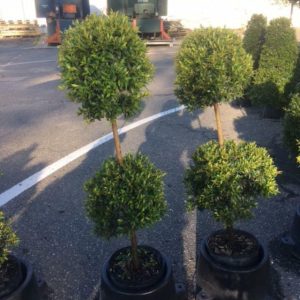Description
Taxus – Yew –
There are 5-10 broadly rounded to upright, dioecious or change sex over time, evergreen, coniferous, large shrubs or small trees, that are slow growing and long lived within the Taxaceae family, in this genus. They are found naturally occurring in forest extending from North temperate areas to the Philippines and Central America. Yews are grown for lanceolate, needle like dark green leaves with prominent olive green midribs, with paler undersides, these are arranged spirally but often appear 2 ranked.. Over the centuries they develop domed crowns and a massive thick trunk clothed in reddish brown or grayish brown bark which peels off in thin scales. On the female plants, single seeded, egg to oblong shaped vivid red fruits are produced in fleshy berries called an aril and mature in 6-9 months. Grow as specimen plants or use as hedges and topiary, the prostrate forms make a good ground cove, even in dense shade. Most tolerate coastal exposure, dry soils, and urban pollution. All parts (except the fleshy red seed coats) are highly toxic if ingested, it said to kill some livestock.. Birds are able to break down the toxins.
Grow in any well drained, fertile soil, including alkaline or chalky, acidic soils, in sun or deep shade. Trim hedges in summer and early fall.
Prone to black vine weevil, mealybugs, mites, scale insects, phtyophtora dieback, root rot, needle blights and some lepidopteran insects.
T. baccata ‘Adpressa’ – Common Yew – English Yew -This extremely long lived, slow growing, broadly conical tree from Europe, North Africa to Iran grows to 20′ feet tall and 12′ feet wide. It has reddish-brown bark. On horizontally held branches it produces linear, glossy, green abruptly pointed leaves, up to 1/2″ long, with paler undersides are 2 ranked and parted either side of the shoots. Yellow scaly male cones are borne in spring. Fruit consist of single green seeds with juicy, sweet, usually red arils, ½” across.
Zones 7-8




